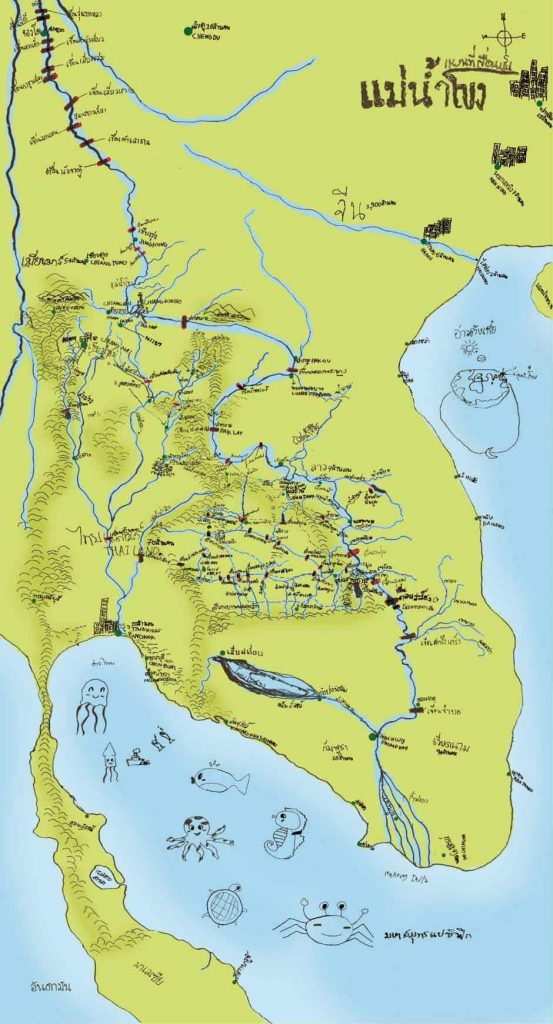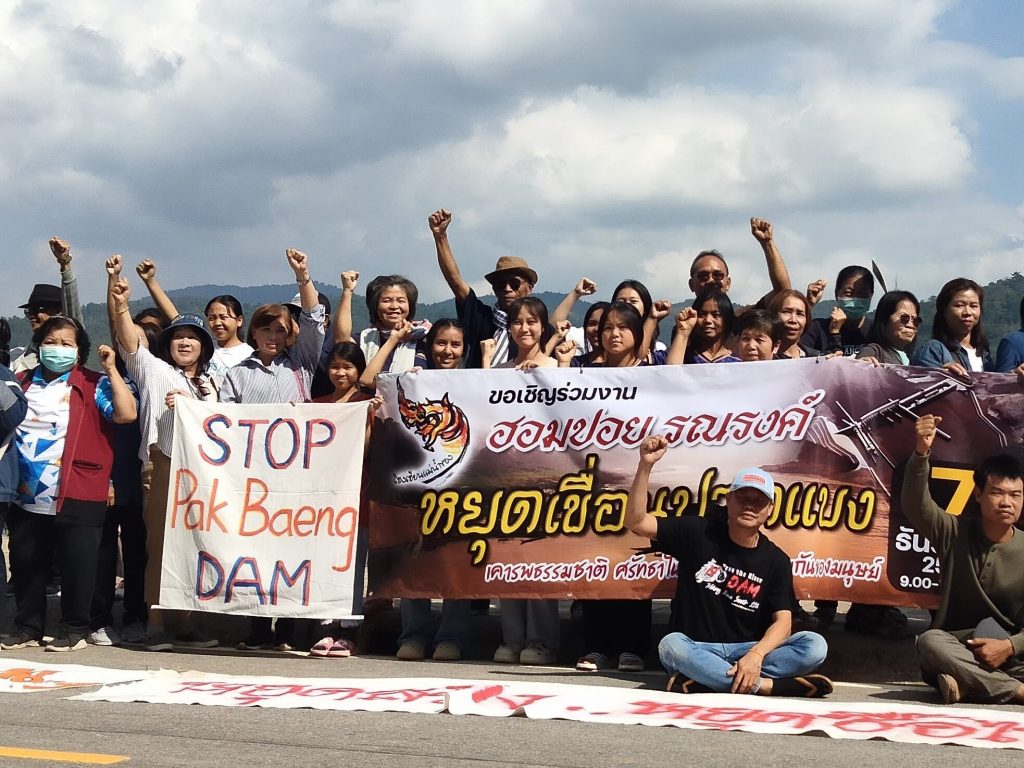[By Kru Tee-Niwat Roikaew, Nopparat Lamun: Mekong School : Institute of Local Knowledge, Chiang Khong Conservation Group, 2 April 2025]
Thank you for honoring me with the opportunity to discuss the urgent issues of river management or environmental management in the Mekong region, including the working approaches of the Mekong People’s Network and Communities in Thailand.
First of all, I would like to express my condolences to the victims of the earthquake in Myanmar, Thailand and China, which was epicentered in Skye District, Myanmar on March 28. The tremors measured 7.7 on the Richter scale and were felt in the upper and middle Mekong Rivers.
Over the nearly three decades of hydroelectric dams being built on the upper Mekong River in China, there are now 12 known dams on the upper Mekong River (Some reports say 13 dams), storing water and sediment that are essential for the Mekong’s fertility. People downstream, such as the Mekong River basin communities in Chiang Rai Province, have been severely impacted by the cumulative impacts and changes to the environment, fisheries and agricultural communities.

Credit Picture: Mekong Dam’s Map By Mekong Youth Program, Mekong School
Two completed dams, Xayaburi and Don Sahong, have been in operation for the past 5-6 years and have already created clear impacts. Xayaburi is the first major dam on the lower Mekong River to start operation. The Electricity Generating Authority of Thailand (EGAT) purchases approximately 95% of the electricity from this dam. The project has undergone the MRC Prior Consultation process, with the Cambodian and Vietnamese governments expressing serious concerns about the impacts.
The impact is clear after the dam has started generating electricity, severely affecting the way of life of the riverside communities and the riverside ecosystem, without any effective mitigation, correction or remedy measures.
Communities along the Mekong River and many of its tributaries have experienced unusual fluctuations in water levels since the dams began operating, including a decrease in sediment levels, leading to the distinct blue-green river phenomenon in Nakhon Phanom Province, or the “hungry sediment’s river” condition.
Fish catches have declined dramatically, with some Thai fishermen reporting losses of up to 80%. This has led to food shortages and a worsening quality of life for people in Thailand’s northeastern region, while the construction of fish passages by dam developers has not been able to tell the type and number of fish that will be able to pass through.
The dam has caused severe erosion along the banks of the Mekong and Khan rivers, affecting Luang Prabang, requiring a World Bank-funded rehabilitation project. Luang Prabang has become a “lake city at the end of the Xayaburi Reservoir.”
Traditional fishing methods developed over Hundreds of thousands of years are becoming ineffective due to rapid and severe fluctuations in water levels, which destroy important fish spawning habitats. Inshore agriculture is collapsing.
That is the clear impact of the completed dam.
Photo credit: Xayaburi Dam by ผู้จัดการออนไลน์
The push to build more dams will only worsen the Mekong River’s near-death state. The same is true of rushing to build the massive 1,460 megawatt Luang Prabang dam in 2020, located near the UNESCO World Heritage city of Luang Prabang. Although construction is underway and a power purchase agreement has been signed, questions remain about the adequacy of environmental and heritage impact assessments, and the potential long-term impacts on the region’s cultural and ecological integrity.
In addition, from the survey in early 2024, we found that in addition to the construction of the Luang Prabang Dam, there were also mining concessions along the banks of the Mekong River in Don (Island) and the mouths of tributaries before the water flooded the area. This mining can be seen along both sides of the Mekong River from the north of the Luang Prabang Dam to Pak Beng. We found mining along the banks of the Mekong again, from the north of the Pak Beng Dam up to the area of Bokeo Province – Chiang Rai Province.
If counting from the Thai-Laos border, from the Golden Triangle down the river, Pak Beng Dam is the first dam, located only 96 km south of Kaeng Pha Dai, Ban Huai Luek, Tambon Muang Yai, Amphoe Wiang Kaen, Chiang Rai Province. The installed electricity generation capacity is 912 megawatts.
The Pak Beng Dam Prior Consultation process was initiated with the MRC in December 2016, with a Power Purchase Agreement (PPA) signed with EGAT (Thailand) in September 2023, with a scheduled commercial operation date of 2033. Construction is expected to commence on 1 October 2025, with a scheduled commercial operation date of 1 January 2033.
The Mekong-Thailand People’s Network submitted a letter to banks in Thailand, requesting a suspension of loans in October 2024, and organized a campaign to call for the cancellation of the Pak Beng Dam on December 7, 2024. Although the PNPCA process has been completed and the power purchase agreement has been signed, no relevant government agencies and dam developers have been able to provide answers to questions and resolve transboundary impacts for Thai people in Chiang Rai and the Mekong River provinces in the Northeast. Riverside communities and local governments reported that they have not received clear information about the potential and cumulative impacts of the dam, despite requests for information.
The major transboundary impacts on the Mekong River in Chiang Rai Province are the impacts of the backflow or flow of water to tributaries such as the Ngao River, which is the basin of the old city and the location of Wiang Kaen District today, the Ing River in Chiang Khong District, Chiang Rai Province, is an important agricultural lowland in northern Thailand. This backflow will inundate agricultural areas, the old city, and coastal ecosystems, and the Don (Islands.)
Photo credit : เขื่อนหลวงพระบาง
From the planned water level of the dam at 340 meters above sea level, the dam could cause water levels to rise significantly in Thailand, increasing the risk of severe flooding and destroying valuable agricultural areas and archaeological sites, changing the ecosystem and the flow of the river, which will affect aquatic animals and plants such as fish and Mekong algae, and is a concern for food security due to the decline in the number of fish and aquatic plants that are an important source of food/protein and income for riverine communities.
In addition, the disappearance of the Mekong River area on the Thai-Laos border, islands, and beaches has implications for territorial sovereignty. It is important to note that the project does not include a backflow model in the dam developer’s report, which would assess the potential impacts on Thai communities. The Office of National Water Resources (ONWR) has acknowledged this issue. In addition, the Department of Treaties and Laws and the Royal Thai Navy have expressed concerns about the impacts of backflow on the Thai border in the Mekong River.
Another case that was discussed today is the Sanakham Dam, a dam on the Mekong River located just 2 km from the Thai border from the mouth of the Huang River in Chiang Khan District, Loei Province, with a capacity of 684 MW. This project is under consideration under the Prior Consultation process (PNPCA) of the Mekong River Commission (MRC). The Office of National Water Resources (ONWR) of Thailand has organized a public hearing in areas that may be affected, with the fourth and final public hearing held in Bueng Kan Province on 14 February 2025 to formally collect Thailand’s opinions to present to the government and the MRC. The MRC had previously rejected the technical report of the Sanakham Dam, stating that the information on the impacts to downstream countries was still unclear.
The Thai Ombudsman has visited the area to study the problems and impacts of the project and has made recommendations on the possible impacts on Thailand after the Mekong River Protection Network of the Northeast and the North submitted a request to investigate the matter. And the Mekong Freedom Network and 12 other civil society organizations sued ONWR for dereliction of duty and proceeding with the project without complete information in December 2014.
The Sanakham Dam project is another example of the complexities of transboundary impacts. The MRC’s rejection of the technical report reflects regional concerns. Civil society’s action to sue ONWR indicates dissatisfaction with the participation and disclosure process, as well as concerns about possible transboundary impacts such as changes in the deep water channel, bank erosion, boundary changes, and impacts on fisheries and livelihoods of people living along the Mekong River.

The Role of the Mekong River Commission (MRC) and the Office of National Water Resources (ONWR) in Sustainable Governance of the Mekong River
As we all know, the lower Mekong Basin countries have a central organization under the Agreement on Cooperation for the Sustainable Development of the Mekong Basin on April 5, 1995 in Chiang Rai Province, with Cambodia, Laos, Thailand and Vietnam, to jointly create and for mutual benefit for sustainable development, use, conservation and management of water resources and related resources of the Mekong Basin. (MRC)
The development of all the lower Mekong dams mentioned above, MRC-the central organization that acts as a coordinator, creates sustainable management of the Mekong River according to the agreement of the 4 countries, has not yet reached the point of having member countries comply with the agreement transparently and fairly, especially the Prior Consultation Process (PNPCA), which is a process that facilitates the construction of dams because it cannot stop the construction of dams that have impacts on the environment, economy and society of tens of millions of people. It only finds solutions to problems when the dams are completed.
The main reason is that the development of hydropower dams lacks a true participatory process, and lacks a thorough and truly transparent study of cross-border impacts.
Regarding the Pak Beng and Sanakham dams, which are not far from the Thai border, there have been many observations of the lack of transparency in information disclosure and public participation in decision-making from many parties.
The cumulative impact pressures on the lower Mekong River over nearly three decades from China’s hydropower dams upstream, as more dams are built on the lower Mekong River, the river is likely to become a reservoir, and concerns about the cumulative impacts of multiple dams on the Mekong River are heightened, with security concerns about changes to the Mekong River’s deep channel that could affect patrols and transnational crime, and sovereignty issues, all worsening the situation.
Thank you all.



